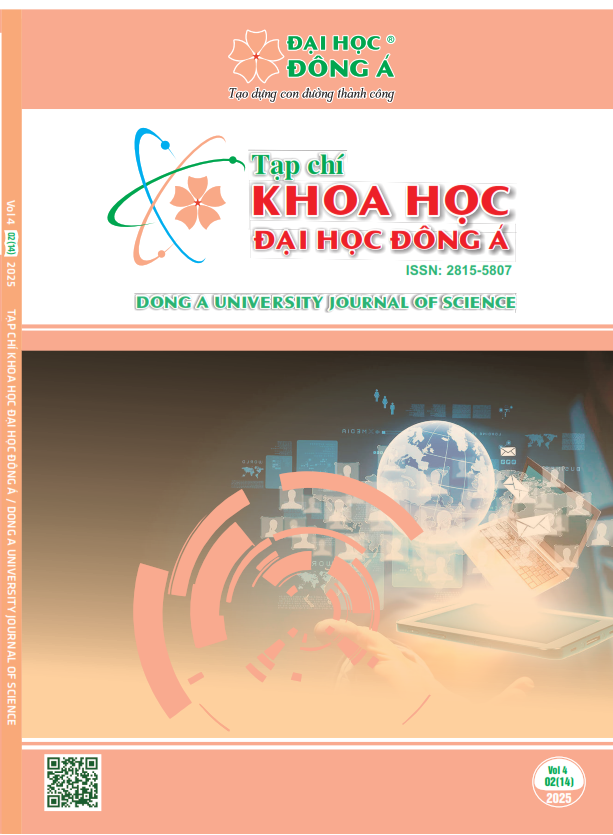Application of GIS-Based Neighborhood Analysis to Assess The Impacts of Land Cover on Land Surface Temperature in Ho Chi Minh City
Main Article Content
Abstract
Land surface temperature (LST) monitoring using remote sensing is widely applied, but the influence of land cover on LST has received limited attention in the literature. This study aims to analyze the impact of various land cover types on LST in Ho Chi Minh City (HCMC), one of the fastest-growing urban areas in Southeast Asia. Based on Landsat 8 satellite imagery acquired on March 29, 2015, the maximum likelihood classification method was used to classify land cover into seven types: impervious surfaces, bare land, water bodies, clouds, dense vegetation, sparse vegetation, and moderate vegetation. LST values were extracted using the land surface emissivity coefficient and vegetation index. The impact of land cover on LST was assessed using neighborhood analysis in GIS. The results show that impervious surfaces are the dominant land cover in HCMC, with most areas having an LST of 34.9°C or lower. Additionally, the average LST of impervious surfaces and bare land decreases as neighboring pixels have higher vegetation cover. Impervious surfaces and bare land in neighboring pixels increase the average LST of water body pixels. The average LST of vegetation pixels is inversely correlated with the vegetation cover of neighboring pixels. These findings provide crucial insights into urban heat management and can inform strategies for mitigating the impact of LST on the urban environment, such as increasing green spaces and improving urban planning.
Article Details

This work is licensed under a Creative Commons Attribution-NonCommercial-NoDerivatives 4.0 International License.
Keywords
Neighborhood analysis, land cover, land surface temperature, Landsat 8, Ho Chi Minh City
References
Alavipanah, S., Wegmann, M., Qureshi, S., Weng, Q., & Koellner, T. (2015). The Role of Vegetation in Mitigating Urban Land Surface Temperatures: A Case Study of Munich, Germany during the Warm Season. Sustainability, 7(4), 4689–4706. https://doi.org/10.3390/su7044689
Caselles, E., Abad, F. J., Valor, E., & Caselles, V. (2011). Automatic Generation of Land Surface Emissivity Maps. In Climate Change - Research and Technology for Adaptation and Mitigation (pp. 102–114). InTech.
Christina Koppe, Kovats, S., Jendritzky, G., & Menne, B. (2004). Heat-waves: risks and responses. World health Organization. Health and Global Environmental Change. Series, No. 2. Copenhagen.
ESRI. (2024). Focal Statistics. http://desktop.arcgis.com/en/arcmap/10.3/tools/spatial-analyst-toolbox/focal-statistics.htm
Jiang, Y., Fu, P., & Weng, Q. (2015). Assessing the Impacts of Urbanization-Associated Land Use/Cover Change on Land Surface Temperature and Surface Moisture: A Case Study in the Midwestern United States. Remote Sensing, 7(4), 4880–4898.
Lê Vân Anh, & Trần Anh Tuấn. (2014). Nghiên cứu nhiệt độ bề mặt sử dụng phương pháp tính toán độ phát xạ từ chỉ số thực vật. Tạp Chí Các Khoa Học Về Trái Đất, 36(2), 184–192.
Lo, C. P., Luvall, J. C., & Quattrochi, D. a. (1997). Application of high-resolution thermal infrared remote sensing and GIS to assess the urban heat island effect. International Journal of Remote Sensing, 18(2), 287–304.
Lương Văn Việt. (2007). Sự phát triển đô thị và xu thế biến đổi khí hậu tại thành phố Hồ Chí Minh. Tạp Chí Khí Tượng Thủy Văn, 558, 29–36.
NASA. (2011). Atmospheric Correction Parameter Calculator. http://atmcorr.gsfc.nasa.gov/
Ouyang, X., Jia, L., Pan, Y., & Hu, G. (2014). Retrieval of Land Surface Temperature over the Heihe River Basin Using HJ-1B Thermal Infrared Data. Remote Sensing, 7(1), 300–318. https://doi.org/10.3390/rs70100300
Sohl, T. L., & Sohl, L. B. (2012). Land-Use Change in the Atlantic Coastal Pine Barrens Ecoregion. Geographical Review, 102(2), 180–201.
Sun, D. (2003). Estimation of land surface temperature from a Geostationary Operational Environmental Satellite (GOES-8). Journal of Geophysical Research, 108(D11). https://doi.org/10.1029/2002JD002422
The Weather Company. LCC. (2016). Weather UnderGround. https://www.wunderground.com/
Trần Thị Vân. (2011). Nghiên cứu biến đổi nhiệt độ đô thị dưới tác động của quá trình đô thị hóa bằng phương pháp viễn thám và GIS, trường hợp khu vực thành phố Hồ Chí Minh. Luận văn tiến sĩ. Đại học Quốc gia TP.HCM.
UBND thành phố Hồ Chí Minh. (2024). Báo cáo tổng hợp quy hoạch thành phố Hồ Chí Minh thời kì 2021-2030, tầm nhìn đến năm 2050.
UN-Habitat (United Nations Human Settlements Programme). (2011). Global report on human settlements 2011: Cities and Climate Change. Earthscan. https://doi.org/10.1787/9789264091375-en
Ủy ban nhân dân TP. Hồ Chí Minh. (2011). Điều kiện tự nhiên. http://www.hochiminhcity.gov.vn/thongtinthanhpho/gioithieu/Lists/Posts/AllPosts.aspx?CategoryId=17
Valor, E., & Caselles, V. (1996). Mapping Land Surface Emissivity from NDVI: Application to European, African, and South American Area. Remote Sensing of the Environment, 57, 167–184.
Van De Griend, a. a., & Owe, M. (1993). On the relationship between thermal emissivity and the Normalized Difference Vegetation Index for natural surfaces. International Journal of Remote SensingSensing, 14(6), 1119–1131.
Weng, Q., Lu, D., & Schubring, J. (2004). Estimation of land surface temperature–vegetation abundance relationship for urban heat island studies. Remote Sensing of Environment, 89(4), 467–483. https://doi.org/10.1016/j.rse.2003.11.005
Wilhelmi, O. V, Purvis, K. L., & Harriss, R. C. (2004). Designing a Geospatial Information Infrastructure for Mitigation of Heat Wave Hazards in Urban Areas. Natural Hazards Review, 5(3), 147–158. https://doi.org/10.1061/(ASCE)1527-6988(2004)5:3(147)


